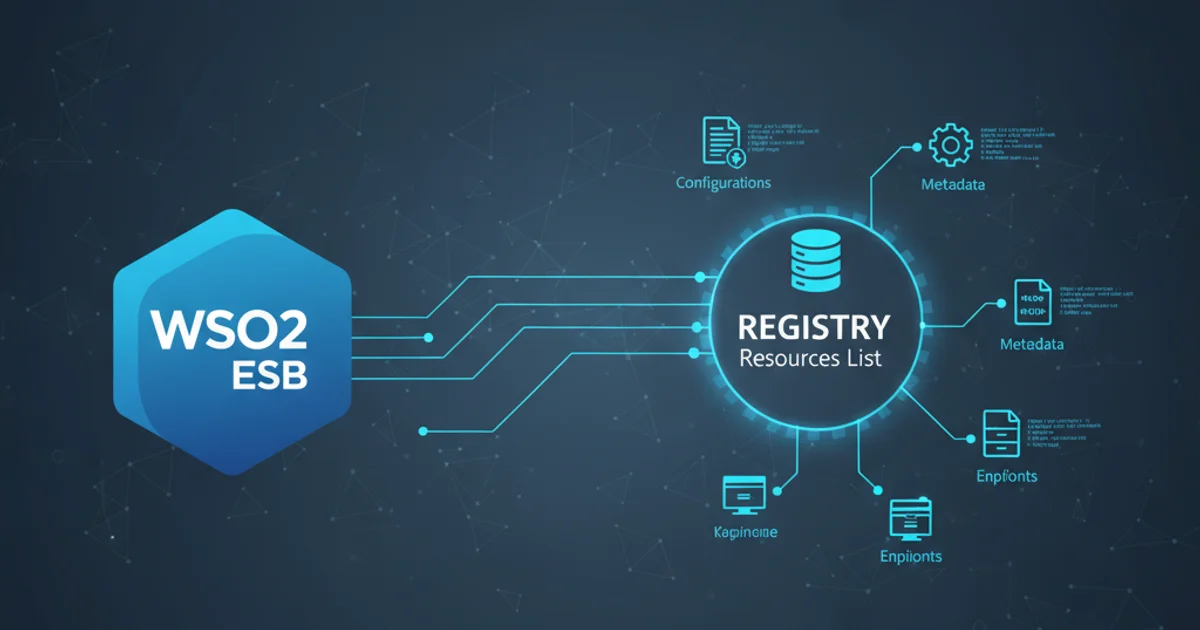WSO2 ESB registry Resources List
Categories:
Managing WSO2 ESB Registry Resources: A Comprehensive Guide

Learn how to effectively list, access, and manage resources stored in the WSO2 ESB Registry, including endpoints, sequences, and XSLT transformations.
The WSO2 Enterprise Service Bus (ESB) leverages a powerful registry component to store and manage various configuration artifacts and runtime resources. This registry acts as a central repository for items like endpoints, sequences, XSLT transformations, WSDLs, and more. Efficiently listing and understanding these resources is crucial for monitoring, debugging, and maintaining your ESB deployments. This article will guide you through the process of accessing and listing these vital registry resources.
Understanding the WSO2 ESB Registry
The WSO2 ESB Registry is an integral part of the WSO2 Carbon platform, providing a persistent storage mechanism for configuration and governance artifacts. It supports versioning, access control, and a hierarchical structure, making it ideal for managing shared resources across multiple services and proxies. Resources stored in the registry can be dynamically loaded by the ESB, allowing for flexible and hot-deployable configurations without requiring a full server restart.
flowchart TD
A[WSO2 ESB] --> B("Registry API/UI");
B --> C{Registry Service};
C --> D[Resource Storage];
D -- "Stores" --> E["Endpoints (e.g., /_config/endpoints/)"];
D -- "Stores" --> F["Sequences (e.g., /_config/sequences/)"];
D -- "Stores" --> G["XSLT, WSDL, Schemas"];
D -- "Stores" --> H["Custom Resources"];
E -- "Accessed by" --> A;
F -- "Accessed by" --> A;
G -- "Accessed by" --> A;
H -- "Accessed by" --> A;High-level overview of WSO2 ESB Registry interaction
Accessing Registry Resources via the Management Console
The most straightforward way to view and manage registry resources is through the WSO2 ESB Management Console. This web-based interface provides a user-friendly way to browse the registry's hierarchical structure, inspect resource content, and perform basic management operations.
1. Log in to the Management Console
Open your web browser and navigate to the WSO2 ESB Management Console URL (typically https://<ESB_HOST>:<ESB_PORT>/carbon). Log in with your administrator credentials.
2. Navigate to the Registry Browser
In the left-hand navigation pane, under the 'Main' menu, expand 'Resources' and click on 'Browse'.
3. Explore Registry Paths
The Registry Browser will display the root of the registry. You can navigate through the folders to find specific resource types:
- Endpoints: Typically found under
/_system/config/endpointsor/_system/governance/endpoints. - Sequences: Often located under
/_system/config/sequences. - XSLT Transformations: Can be stored in various locations, commonly
/_system/config/xsltor a custom path.
4. View Resource Details
Click on a specific resource (e.g., an endpoint or sequence) to view its content, properties, and version history. You can also edit or delete resources from this interface.
/_system/config and /_system/governance paths.Listing Registry Resources Programmatically (Admin Services)
For automated tasks, scripting, or integration with external systems, you can programmatically access the WSO2 ESB Registry using its Admin Services. The RegistryAdminService provides methods to list resources, get resource content, and manage the registry remotely. This is particularly useful for CI/CD pipelines or custom monitoring tools.
Here's an example of how you might interact with the RegistryAdminService using a SOAP client (e.g., Apache Axis2 client in Java) to list resources within a specific path. While the full client setup is extensive, the core method call is illustrative.
import org.wso2.carbon.registry.ws.client.RegistryWSServiceClient;
import org.wso2.carbon.registry.core.Resource;
import org.wso2.carbon.registry.core.Collection;
// ... (Assume client setup and authentication is done)
RegistryWSServiceClient registryClient = new RegistryWSServiceClient(serviceURL, username, password);
String path = "/_system/config/endpoints";
try {
Resource resource = registryClient.get(path);
if (resource instanceof Collection) {
Collection collection = (Collection) resource;
String[] children = collection.getChildren();
System.out.println("Resources under " + path + ":");
for (String childPath : children) {
System.out.println(" - " + childPath);
}
} else {
System.out.println("Path is not a collection: " + path);
}
} catch (Exception e) {
System.err.println("Error accessing registry: " + e.getMessage());
e.printStackTrace();
}
Java code snippet to list registry resources using RegistryAdminService